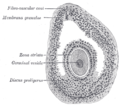Ovarian follicle
Ovarian follicle
An Ovarian follicle is a fluid-filled sac that contains an immature egg, or oocyte. These follicles are found in the ovaries. Each month during a woman's menstrual cycle, an ovarian follicle releases an egg during ovulation.
Structure
The ovarian follicle is made up of several parts:
- Oocyte: The immature egg within the follicle.
- Granulosa cells: These cells surround the oocyte and produce estrogen.
- Theca cells': These cells are located outside the granulosa cells and also produce estrogen.
- Antrum: The fluid-filled space within the follicle.
Development
Ovarian follicles develop in stages:
- Primordial follicle: The earliest stage of a follicle, present at birth.
- Primary follicle: The follicle begins to grow in response to follicle-stimulating hormone (FSH).
- Secondary follicle: The follicle continues to grow and the antrum begins to form.
- Mature (Graafian) follicle: The follicle is ready to release its egg during ovulation.
Function
The main function of the ovarian follicle is to produce and release an egg for potential fertilization. The follicle also produces estrogen, which prepares the uterus for pregnancy.
Clinical significance
Problems with ovarian follicles can lead to several medical conditions, including polycystic ovary syndrome (PCOS) and infertility. Treatments for these conditions may include hormone therapy and in vitro fertilization (IVF).
See also
Transform your life with W8MD's budget GLP-1 injections from $125.
W8MD offers a medical weight loss program to lose weight in Philadelphia. Our physician-supervised medical weight loss provides:
- Most insurances accepted or discounted self-pay rates. We will obtain insurance prior authorizations if needed.
- Generic GLP1 weight loss injections from $125 for the starting dose.
- Also offer prescription weight loss medications including Phentermine, Qsymia, Diethylpropion, Contrave etc.
NYC weight loss doctor appointments
Start your NYC weight loss journey today at our NYC medical weight loss and Philadelphia medical weight loss clinics.
- Call 718-946-5500 to lose weight in NYC or for medical weight loss in Philadelphia 215-676-2334.
- Tags:NYC medical weight loss, Philadelphia lose weight Zepbound NYC, Budget GLP1 weight loss injections, Wegovy Philadelphia, Wegovy NYC, Philadelphia medical weight loss, Brookly weight loss and Wegovy NYC
|
WikiMD's Wellness Encyclopedia |
| Let Food Be Thy Medicine Medicine Thy Food - Hippocrates |
Medical Disclaimer: WikiMD is not a substitute for professional medical advice. The information on WikiMD is provided as an information resource only, may be incorrect, outdated or misleading, and is not to be used or relied on for any diagnostic or treatment purposes. Please consult your health care provider before making any healthcare decisions or for guidance about a specific medical condition. WikiMD expressly disclaims responsibility, and shall have no liability, for any damages, loss, injury, or liability whatsoever suffered as a result of your reliance on the information contained in this site. By visiting this site you agree to the foregoing terms and conditions, which may from time to time be changed or supplemented by WikiMD. If you do not agree to the foregoing terms and conditions, you should not enter or use this site. See full disclaimer.
Credits:Most images are courtesy of Wikimedia commons, and templates, categories Wikipedia, licensed under CC BY SA or similar.
Contributors: Prab R. Tumpati, MD




